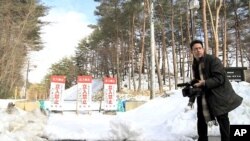VOA Northeast Asia Correspondent Steve Herman began reporting online and on-air moments after a massive earthquake and tsunami struck Japan one year ago on March 11. He and John Glionna of The Los Angeles Times were among the first journalists to go into the exclusion zone and to reach the gates of the Fukushima-1 nuclear plant. In subsequent days and weeks, Herman's on-scene reporting - on the web, on radio and television and via Twitter and other social media - earned him a global reputation as a quick, reliable and dispassionate first-hand observer of the ongoing disaster. In this essay he reflects on the significance of the event and the long-lasting problems created by the Earth's undersea upheaval last year.
It is still difficult to grasp the enormity of Japan's disastrous 9.0-magnitude earthquake and tsunami and to realize how close the nation came to an unimaginable evacuation of Tokyo.
The overall tally from the natural disaster is sobering: 20,000 people killed - most by the tsunami - more than a quarter of a million buildings destroyed, and nearly 400,000 people made homeless.
The human tragedy has been heartrending. Some parents are still hunting for the bodies of their children. More than 1,500 children have lost at least one of their parents.
The unprecedented physical destruction has also left Japan with piles of debris, known as gareki. What to do with all of that gareki is still a question the country is grappling with.
Some rebuilding has commenced, but a major frustration is that too many people are languishing in temporary housing.
There is also concern about some coastal communities that were losing young people through migration to urban areas even before the disaster. Those communities may never recover.
Here in Fukushima prefecture there are many people who desire to return home, but a lack of adequate infrastructure and fears of radiation poisoning are compelling them to stay away.
Awareness of radiation levels has become the norm for people in Fukushima. Every community in the prefecture is dotted with solar-powered radiation monitoring posts, displaying in large numbers on-the-spot data, measured in microsieverts per hour. Some businessmen and housewives can be seen discreetly checking pocket geiger counters.
The radiation fears can be irrational; some Japanese have even left Tokyo, although background radiation levels are lower there than in some other cities around the world.
Some scientists and government officials assure the public that radiation levels are safe, even close to the crippled Fukushima Daiichi nuclear plant. But since the disaster, the Japanese people have displayed a growing distrust in authority figures.
That, in great part, stems from the little accurate information during the early days of the crisis from the government, the Tokyo Electric Power Company and the media. The overriding concern among bureaucrats and media editors in Japan seemed to have been avoiding general panic, rather than full transparency. (The Kyodo news service has reported that as early as six hours after the earthquake hit, the Japanese government was aware of the possibility of a nuclear meltdown at Fukushima, but "was reluctant to actively disclose information to the public.")
Despite several reports blaming the government and industry for improper safeguards, poor planning and non-disclosure of vital information, no one has been charged with a crime. Japan's prime minister at the time, Naoto Kan, said no single person or entity is wholly to blame, and many must share responsibility for what happened, including himself.
I was among those near the atomic power facility on the 15th of March when, unknown to the public, an estimated 10 million becquerels per hour of radioactive substances spewed from the three crippled reactors. For days, I and millions of people in Japan absorbed significantly higher doses of radiation than we normally would have been exposed to.
Subsequent testing has shown no levels on my body or clothing that required decontamination, and I have suffered no ill effects I can even remotely attribute to radiation.
No one has died from radiation as a result of the accident, but delayed and poorly arranged evacuations of some Fukushima hospitals and other care facilities are blamed for scores of patient deaths.
The reactor meltdowns have destroyed many livelihoods. They have also diminished confidence in Fukushima's agriculture sector, one of Japan's most prosperous areas for rice and produce.
Some predict the accident will ultimately end Japan's nuclear power industry, which has met 30 percent of the nation's energy needs. That is not a good prospect for a highly industrious but resource-poor nation. Going back to the days when Japan relied more heavily on imported and expensive fossil fuels could further damage its efforts to reverse a decades-long economic slide.
The country also finds itself facing a huge bill for cleaning up after the nuclear disaster and for paying compensation to victims. That is estimated to be more than $250 billion. Even for the world's third-largest economy, that is a staggering sum.
